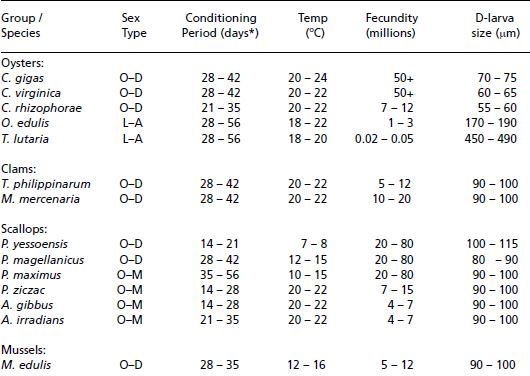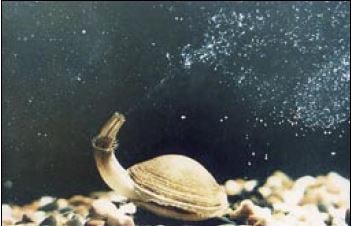4.2 SPAWNING AND FERTILIZATION
4.2.1 Introduction
A summary of information pertinent to conditioning and egg/larval production for a number of commonly cultured bivalves is given in Table 9.
Many temperate and cold water climate bivalves will require 4 to 8 weeks of conditioning to reach spawning readiness during late winter and early spring (Figure 38). A progressively shorter period will be required as the natural breeding season approaches. Precise timing depends on the species being conditioned, the initial condition of the broodstock, stage in gametogenesis when the bivalves begin conditioning and hatchery
related factors, the most important of which are temperature, diet and ration. Hatchery operators will normally use stock already undergoing gametogenesis when returned from the sea, rather than begin conditioning with sexually undifferentiated adults. Advantage can be taken during the natural spawning period of the generally better quality of eggs in terms of important reserves (particularly lipids) from adults brought into the hatchery directly from the sea. These adults may only require 7 to 12 days at conditioning temperature with an adequate food ration to mature their gametes.
When given an adequate food supply, many coastal and estuarine temperate water bivalves will require between 350 to 650 degree-days (deg d) from the start of conditioning in late winter/early spring to the time they are ready to spawn. The hatchery operator needs to know the temperature at which reproductive development starts in the sea for the species in question. This is often between 8 and 12oC – the “biological zero” (b0) for gametogenesis – for commonly cultured species such as Crassostrea gigas, Ostrea edulis, Pecten maximus and Tapes philippinarum. Knowing what the effective b0 temperature is for reproductive development and the water temperature during the conditioning period, calculation can be made of the number of
Table 9: Summary of information relevant to the conditioning and egg (or larval) production for a number of commonly cultured bivalves. A key to the meaning of the symbols under sex type is given at the bottom of the table. Conditioning times are for adults brought back to the hatchery early in the season (* time in days will vary considerably according to the stage in gametogenesis the adults are in when brought to the hatchery). Fecundity values are a guide only and will vary according to the size of adult spawned, its condition and other factors. The average shell lengths of fully developed, early-stage D-larvae (2–3 days after fertilization) are also given for comparative purposes.

Key to sex-type: O – oviparous (gametes shed into the water); L – larviparous (adults brood larvae which are then shed into the water); D – Dioecious (sexes are separate); M – monoecious (hermaphroditic - both sexes in the same animal); A – alternate sexuality (sex switches in the same animal after each spawning).

Figure 38: A spawning female Manila clam (photograph courtesy Brian Edwards).
days of conditioning required. For example, if the mean conditioning temperature is 20oC and the b0 temperature for reproductive development is 10oC, then every day that passes the number of degree-days will increment by 20 minus 10 = 10. Thus, a 30-day conditioning period at 20oC will accrue 300 deg d and the same period at 22oC will amount to 360 deg d. This represents the likely minimum time period later in spring before stock will be ready to spawn. Obviously, when new stock brought back to the hatchery for conditioning have already started gametogensis, fewer degree-days will be required before the adults are spawning ready.
In cold water scallops, such as Pecten maximus and Placopecten magellanicus, the number of degree-days from the time adults begin conditioning to spawning readiness is within the same range. But the duration of the conditioning period for cold water bivalves can be much longer (sometimes more than 8 weeks) because the maximum temperature of conditioning is no higher than 15 or 16oC and may be as low as 10 to 12oC. Colder water bivalves are often gradually acclimated to the required conditioning temperature by raising temperature from the ambient at a rate of 1 or 2oC per week. This also extends the overall conditioning period.
Spawning is the hatchery procedure by which conditioned bivalves are induced to liberate their mature gametes in response to applied stimuli. In the case of clam and scallop species, viable embryos cannot be obtained from “stripped” gametes (see the next section below for explanation of the term “stripped”). Eggs need to undergo a maturation process during passage down the oviducts before they can be successfully fertilized.